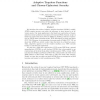EUROCRYPT
2010
Springer
15 years 5 months ago
2010
Springer
106
click to vote
EUROCRYPT
2010
Springer
15 years 5 months ago
2010
Springer
We introduce the notion of adaptive trapdoor functions (ATDFs); roughly, ATDFs remain one-way even when the adversary is given access to an inversion oracle. Our main application ...
109
click to vote
EUROCRYPT
2010
Springer
15 years 5 months ago
2010
Springer
We construct the first public-key encryption scheme that is proven secure (in the standard model, under standard assumptions) even when the attacker gets access to encryptions of ...
EUROCRYPT
2010
Springer
15 years 5 months ago
2010
Springer
We initiate a provable-security treatment of cryptographic agility. A primitive (for example PRFs, authenticated encryption schemes or digital signatures) is agile when multiple, ...
114
Voted
EUROCRYPT
2010
Springer
15 years 5 months ago
2010
Springer
We present a constant-round non-malleable commitment scheme based on the existence of sub-exponential one-way functions and using a blackbox proof of security. As far as we know, t...
110
Voted
EUROCRYPT
2010
Springer
15 years 5 months ago
2010
Springer
A broadcast protocol allows a sender to distribute a message through a point-to-point network to a set of parties, such that (i) all parties receive the same message, even if the s...
101
Voted
EUROCRYPT
2010
Springer
15 years 5 months ago
2010
Springer
This paper presents a formal security analysis of SSH in counter mode in a security model that accurately captures the capabilities of real-world attackers, as well as security-rel...
102
Voted
EUROCRYPT
2010
Springer
15 years 5 months ago
2010
Springer
We analyze the relation between induction, co-induction and the presence of encryption cycles in the context of computationally sound symbolic equivalence of cryptographic express...
120
click to vote
EUROCRYPT
2010
Springer
15 years 5 months ago
2010
Springer
We construct the first public-key encryption scheme in the Bounded-Retrieval Model (BRM), providing security against various forms of adversarial “key leakage” attacks. In th...
EUROCRYPT
2010
Springer
15 years 5 months ago
2010
Springer




